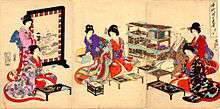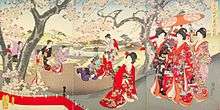Ōoku


The Ōoku (大奥 great interior) refers to the harem of Edo Castle, the section where the women connected to the reigning Shogun resided. Similar areas in the castles of powerful Daimyo, such as the Satsuma Domain, were also referred to by this term.[1]
This included the shōgun's mother, wife, and concubines. Rumored to house several thousand women, including maids and servants at one point, the Ōoku was, as much as any other part of Edo Castle, a focal point of political intrigue for the Tokugawa shogunate.
There were no male adults admitted onto the floor of the Ōoku without the Shōgun. The corridor through which the Shōgun entered was called Osuzu Rōka (御鈴廊下, large corridor of the bells), derived from the ringing of the suzu bells to announce the entrance of the Shōgun. This corridor was the only route which connected the Ōoku to rest of Edo Castle, and it was usually locked.
Later, a second corridor was built as the escape route against disasters such as fires or earthquakes.
A lady in the rank of an Otoshiyori (御年寄) or Jōrō Otoshiyori (上臈御年寄) or the senior ladyship held the reins of power in the Ōoku, while attaining the influence equivalent to a Rōjū in Edo Castle.
The Ōoku was built inside the Edo Castle in 1607 by Tokugawa Hidetada,^ who passed a special law for the Ōoku which was completely separated from the outside world. Therefore, noblewomen living in the Ōoku couldn't leave the castle without permission, and that no women within the Ōoku can have a relationship with man. This system lasted for nearly 200 years.
Notable persons
There were three famous personal ladyship of woman in Ōoku
- Dejima, the personal ladyship of Gekkoin, the mother of Seventh shogun of the Tokugawa Shogunate. She was expelled from Ōoku at 1714 because of a relationship with a man named Ikushima Shinggoro.
- Ikushima the personal ladyship of Tenshoin, She was ousted from the Ōoku at 1859 and stayed with Muraoka, the senior ladyship of the Konoe family, until her death. She was buried at Satsuma.
- Niwata Tsuguko from Kyoto who was the personal ladyship of Princess Kazunomiya, Iemochi's wife. She died 1868 at the Ōoku of Edo castle.
The firsti Jōrō Otoshiyori was Fuku^ or Kusuga no Tsubone ^ , while the last Jōrō Otoshiyori of Ooku was Takiyama, who has served previous shogun, including Tokugawa Ieyoshi and his wife, Tokugawa Iesada and Atsuhime/Tenshouin, Tokugawa Iemochi and Kazunomiya or Seikan'in-no miya, and the last shogun Tokugawa Yoshinobu. After a new government took over Edo Castle, she moved to Kawaguchi, Saitama prefecture. Her remains were buried in Shakujo-ji Temple.
In popular culture
There were many popular portrayals of the Ōoku.[2]
- Ōoku: Hana no Ran (Japanese television drama)
- Atsuhime (NHK Taiga drama)
- Oh! Oku (2006 film)
- Ōoku: The Inner Chambers (Japanese manga)
- Masami Okui best album: Ōoku (2008)
- Ōoku (2010 film)
Notes
^ The name and title of "Ooku" was given by Oeyo, Tokugawa Hidetada's wife
^ Her name before Iemitsu become the third shogun
^ her name after Iemitsu become the third shogun
References
External links
 The dictionary definition of ōoku at Wiktionary
The dictionary definition of ōoku at Wiktionary
Coordinates: 35°41′18″N 139°45′16″E / 35.688324°N 139.754389°E